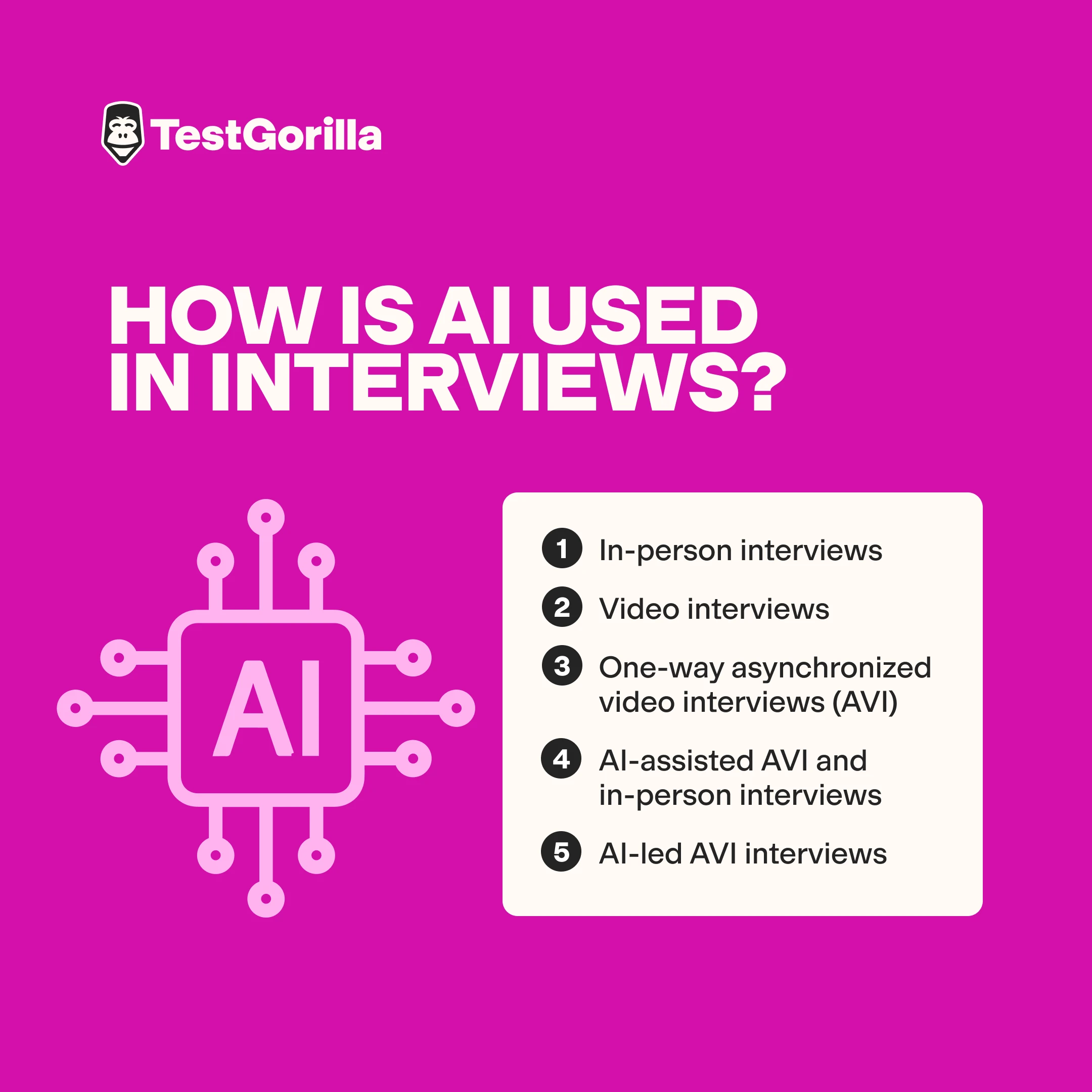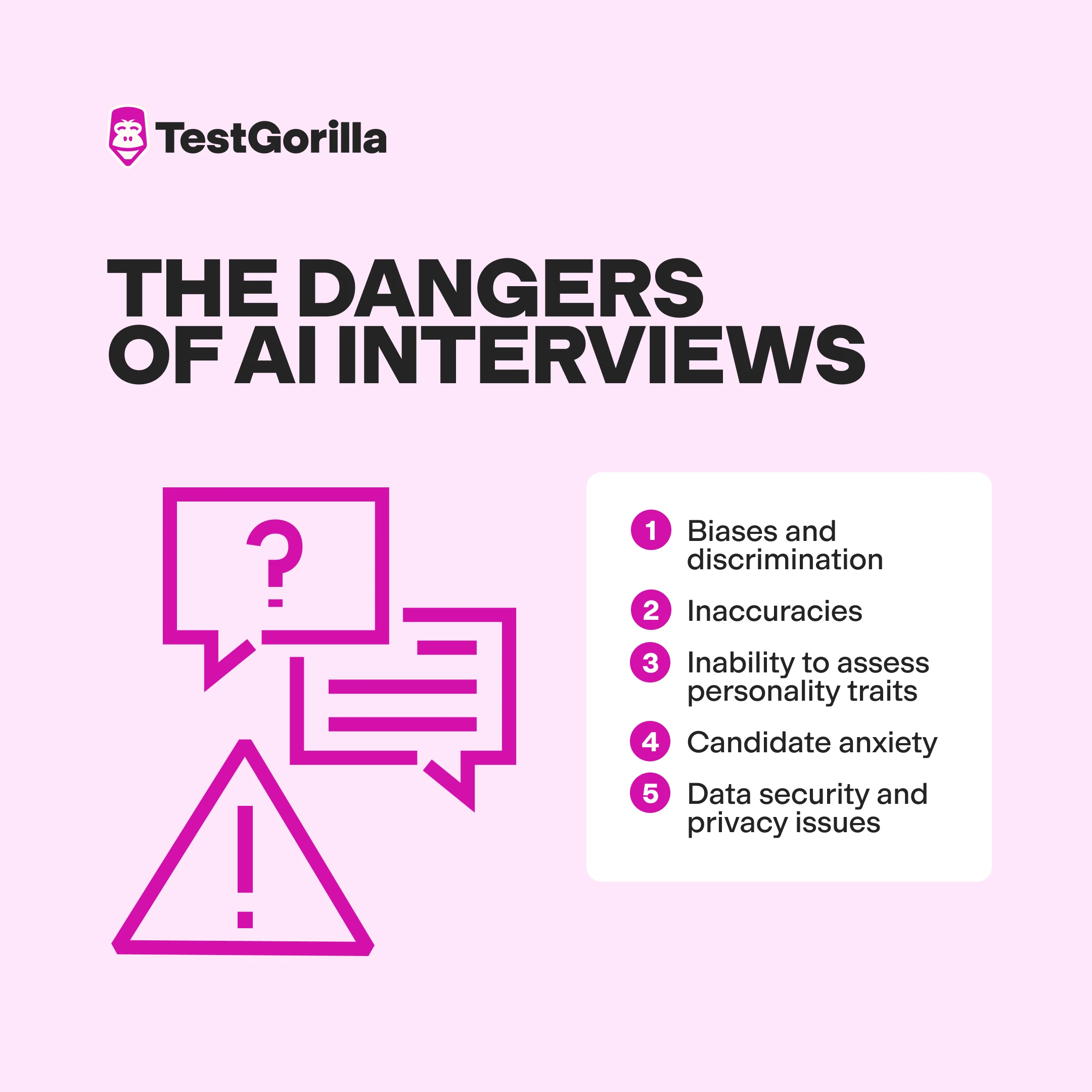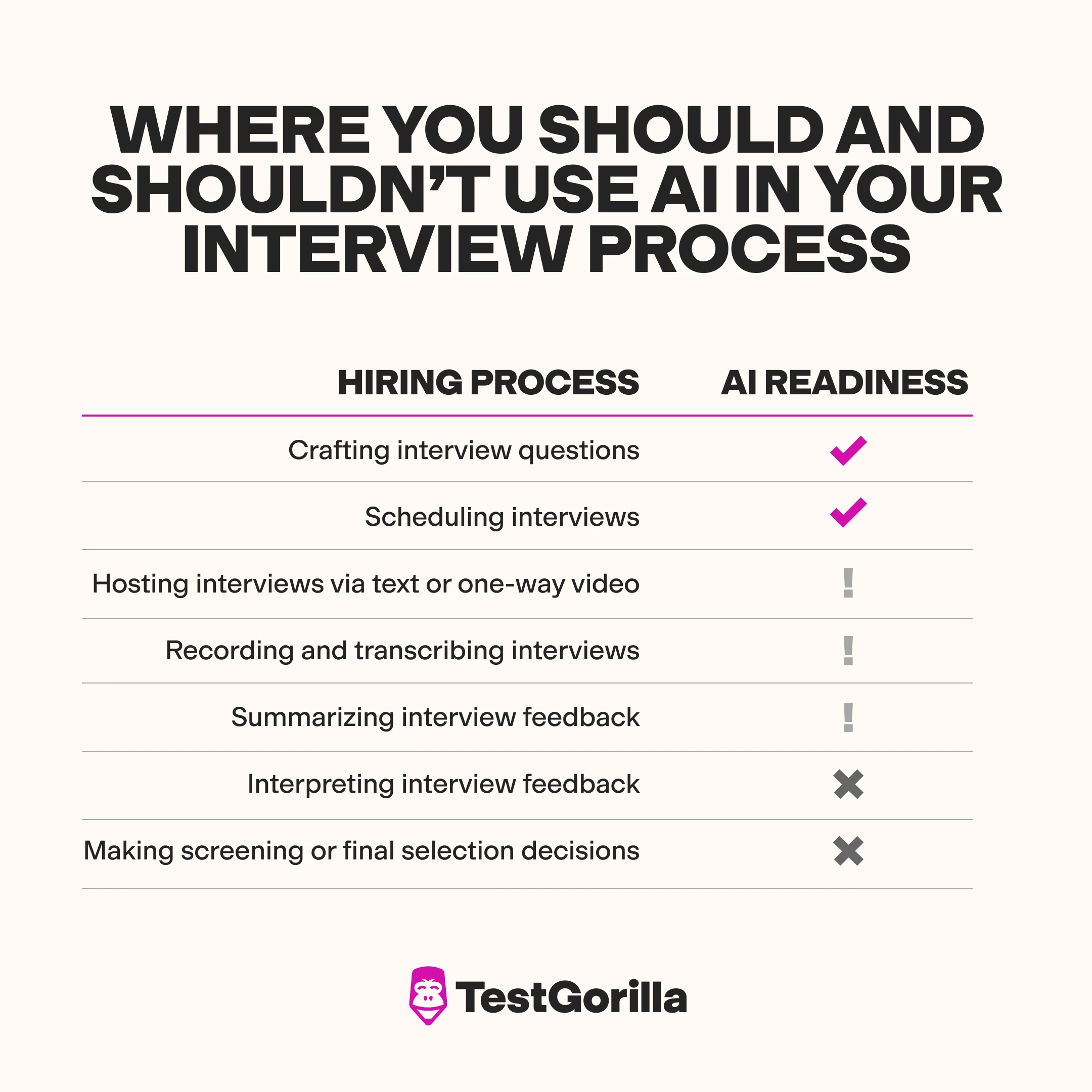AI is not ready to interview job applicants. Here’s why.
AI (artificial intelligence) has helped many employers streamline their hiring processes, reduce time to hire, and save costs. Many employers are now even using AI to interview candidates.
But what are the implications of this? Are these tools really ready to interview candidates without any human involvement? We don’t think so.
However, there are ways to use AI safely and conscientiously in your hiring process. In this article, we look at some of the risks with AI interviews and share how to use AI correctly so you can hire with confidence.
Table of contents
How is AI used in interviews?
AI can be used in several parts of the interview process – from asking candidates qualifying questions over text or video to taking notes and scanning facial expressions, tone of voice, and body language in virtual interviews. In some cases – controversially – AI can even be used to make final hiring decisions.
Let’s look at the various types of interviews, differentiating those that use just tech from those that use AI.
1. In-person interviews
Typically, these interviews involve a live, face-to-face interaction between interviewers and applicants – usually at the company’s office or an offsite location, such as a café.
While you might use tech and AI to schedule the meeting, the interview is entirely human-led. It allows for instant feedback, permits real-time follow-up questions, and helps build rapport between the interviewer and the candidate.
2. Video interviews
These are live, two-way conversations hosted on video conferencing platforms, such as Zoom, Microsoft Teams, Google Meets, etc. Video interviews replicate the immediate feedback and interaction of traditional in-person interviewing while allowing remote participation. These types of interviews use tech but not AI.
3. One-way asynchronized video interviews (AVI)
Candidates participate in a one-way video interview in which they record their responses to predefined questions. Usually, candidates can participate in these interviews at their own convenience using one-way video software like TestGorilla’s. Questions are usually presented as text or through a voice-over tool.
Once candidates’ responses have been recorded, the hiring team reviews the video recordings at a later time. These interviews are almost entirely tech-led but don’t usually use AI. Feedback and decision-making are still very much human-led.
4. AI-assisted AVI and in-person interviews
In AI-assisted AVIs, recorded responses are reviewed by humans but also analyzed by AI algorithms. For example, AI studies candidates’ responses, facial expressions, tone of voice, etc., and helps to identify behavioral traits such as confidence and communication skills.
That said, AI assistance isn’t limited to AVIs. Today, employers also use AI note-takers during two-way virtual or in-person interviews. These help transcribe conversations, summarize key points, and outline action items that emerge from interviews.
Although AI tools assist these interviews, selection decisions remain with recruiters and the hiring team.
5. AI-led AVI interviews
In AI-led video interviews, AI takes a more central role by conducting the interview and making selection decisions. These specialized AI software help with:
Asking questions.
Probing with follow-up questions.
Providing a comprehensive analysis of responses and candidates’ expressions, tone, and body language.
Suggesting which candidates to progress versus reject in the application process.
While the AI tool is usually pre-fed with information about the role, desired skill set, and more, this type of interview occurs without human intervention.
Uncovering the truth: The dangers of AI interviews
AI can help save you a ton of time and effort. However, it can also compromise the quality of your hires and land you in legal trouble. Here are some of the problems you could face with AI interviews:
1. Biases and discrimination
There’s abundant evidence that AI systems can introduce and perpetuate biases in recruitment. Even a tech giant like Amazon stopped using AI screening when its algorithms were found to favor men’s resumes over women’s, regardless of skill.
Ultimately, humans generate, gather, and feed AI systems the datasets that train their algorithms. According to the World Economic Forum, this process can embed human biases in any AI tool – including those used for interviews – if it hasn’t been thoroughly audited for gender, age, religion, and other forms of discrimination. It’s worth noting that the data used to train these models are overwhelmingly “WEIRD” (Western, Educated, Industrialized, Rich, and Democratic). It’s often primarily English or American.
In addition, some AI tools aren’t trained to process and interpret diverse accents. While voice technology tools such as AI notetakers and virtual assistants have made many people’s lives easier, they can be frustrating and unresponsive for speakers with non-standard accents, such as Cockney or African-American vernacular. According to one blog post, many YouTube parody videos demonstrate this. One Reddit user who hosted interviews on Microsoft Teams and used their native transcription function found that the tool wasn’t great at understanding Australian accents.
Given the evidence, can you safely rely on AI systems to record and interpret interviews with no human intervention? Probably not. Not only can this lead to mis-hiring, but it can also cost you top candidates who might be unfairly rejected – and get you sued for discrimination.
2. Inaccuracies
The Society for Human Resource Management (SHRM) published an article about the inaccuracies of AI facial analysis tools, using the well-known video interview software HireVue as an example.
HireVue initially used facial analysis in its interview solution but later removed the feature in response to concerns about its need and accuracy. Internal research is said to have found that “visual analysis no longer significantly added value to the assessments.”
But it wasn’t just that. HireVue’s chief data scientist also shared that while there was a correlation between facial muscle movements and job performance in some customer-facing roles, this wasn’t always the case.
The BBC also linked these inaccuracies to another high-profile case where a make-up artist was screened using HireVue’s AI interview solution. Despite ranking well in skills assessments, the AI tool scored her body language poorly and rejected her for the job.
3. Inability to assess personality traits
Some AI interview software uses facial, voice, and body language analysis to make judgments about candidates’ personality traits and behavioral attributes. However, a study published in the MIT Technology Review has raised major red flags about AI tools’ ability to interpret personality traits.
The study looked at MyInterview, an AI tool that measured candidate personality traits from their video recordings and compiled scores to indicate how closely the candidates’ traits matched what the hiring manager was looking for.
Researchers Sheridan Wall and Hilke Schellmann posted a fake job for an office administrator on MyInterview. Then, they had someone pose as the ideal candidate – with the personality traits required for the role – and participate in an interview.
During the interview, the ideal candidate read a Wikipedia entry aloud in German instead of English. Shockingly, the AI algorithm predicted that the candidate was a 73% match for the fake role, putting her in the top half of the applicants who applied for the job.
As it turned out, the software ignored the content of the answers and interpreted personality traits from the candidate’s voice alone. This demonstrates the danger of using AI interviews to evaluate candidates’ personality traits and assess job fit.
From an applicant's perspective, there's a real concern that AI interviews might unfairly judge them based on biased data or non-verbal cues that don’t reflect their true potential.
Aleksandrina Valcheva, Manager of Customer Success @ TestGorilla
4. Candidate anxiety
In 2023, research firm Pew surveyed 11,000 American adults and found that 71% opposed AI making final hiring decisions. Further, 66% said they wouldn’t apply to employers that used AI in hiring.
Earlier that year, Harvard Business Review reported that while candidates are impressed with AI's novelty, the lack of human connection during interviews can be daunting. Candidates felt “judged” by some sort of superior entity.
In fact, a college graduate recently shared their AI interview experience with Slate, stating:
“We have to do all this song and dance for AI or a robot, or whatever it is, before we even talk to an actual person – if that ever happens.”
When candidates aren’t comfortable with the concept of AI interviews, you risk deterring top talent from applying for a job in the first place.
And even if they do apply, they could feel anxious during the process and find it hard to be themselves when interacting with a machine instead of a person. This discomfort could lead to them not accepting the job if offered and thinking poorly of your company.
5. Data security and privacy issues
AI-powered interview tools can put you at risk of non-compliance with data privacy laws such as the California Consumer Privacy Act (CCPA), General Data Protection Regulation (GDPR), and more.
Here’s a breakdown of possible threats:
Regarding data collection and storage: AI interview tools gather and store candidates’ data, such as their personal information, video recordings, transcripts, etc. Without proper handling, these could be at risk of unauthorized access, especially when using third-party interview software.
Regarding biometric information: AI tools that analyze applicants’ biometric data, such as facial expressions or voices, must prevent this information from being leaked and misused to access candidates’ other personal technologies, such as their phones, digital locks, and more.
Regarding a lack of transparency: Candidates may not be fully aware of what data is collected, how it will be used, and who has access to it. This raises concerns about consent and data privacy.
The good news: Where AI interview tools work well
With all that considered, certain parts of the interview process can benefit from AI assistance. The key is understanding where you should and shouldn’t use AI in interviewing candidates.
Let’s look at how AI can benefit your company’s interview practices.
1. Scheduling interviews
Some software uses AI algorithms to identify interviewers’ available time slots, match them with candidates’ preferences, and automatically send interview invites – with no need for manual effort.
One study showed that 80% of employers using AI interview scheduling saved 36% of their time compared to those who did it manually. HackerRank also found that automated interview scheduling saved recruiters an average of 10 hours per week.
2. Drafting interview questions
Speaking to TestGorilla, HR and hiring expert Yashna Wahal shared that she’s benefitted from using AI to help craft first drafts of interview questions:
“Generative AI tools like ChatGPT have helped me come up with effective interview questions, both at the screening and finalizing interview stages. Crafting interview questions isn’t always easy, especially when you’re not an expert in the role.
I use AI for inspiration and tweak recommended questions with the hiring manager. This leaves us with a well-rounded, robust set of questions relevant to the role and our company.”
3. Transcribing interviews
Despite problems with interpreting accents and background noise, AI notetakers are still widely used for transcribing. In fact, one survey found that nearly 50% of respondents said they used AI for transcribing. A Reddit user also shared that they’ve used AI note-taker Otter.ai for more than 80 interviews.
When used with human supervision, AI notetakers can be a huge time saver and help ensure you don’t miss any important points candidates during their interviews.
Plus, without having to worry about taking notes, you can focus on what the candidate is saying and have a fully engaged conversation with them. The best part? You can use AI notetakers for both virtual and in-person interviews.
4. Summarizing feedback
You can also feed generative AI solutions, such as ChatGPT or Bard, each interviewer’s qualitative and quantitative feedback about candidates. The tools can then summarize key findings and suggest how candidates compare based on set criteria. This saves time manually collating and analyzing feedback, leading to quicker decision-making.
5. Candidate practice
Lastly, AI software can help candidates practice for their interviews in various ways. For example:
Candidates can prompt generative AI tools like ChatGPT to ask them interview questions and receive constructive feedback on their responses, including insights on how to improve their answers.
Applicants might consider using specialized interview software that simulates real-life interviews and provides feedback on their answers.
Some AI tools can help record and critique candidates’ responses, communication skills, non-verbal cues, and more to help increase their confidence before the big day.
Candidates can even use AI tools to imagine how they’d look in different outfits when deciding what to wear for their interviews.
5 tips for making the most of AI interviews
Consider these tips to maximize the benefits and minimize the risks of using AI in interviews:
1. Use AI selectively
First, recognize that you don’t need AI to lead every aspect of your interview process. But equally, you don’t need to completely avoid it either.
The best approach is to use AI for processes in the early hiring stages, such as organizing interviews, but not for interviews.
Carolyn Davies, a graphic designer here at TestGorilla, explains this well:
“There are many parts of the hiring process where tools, automation, and AI can [...] help to reduce bias and also do some of the heavy lifting for recruiters.
But, in my opinion, the interview stage is – and should remain – the most human step in the process.
This is a chance for recruiters to use their conversational skills to build a natural rapport with a candidate (and vice versa). This sets the stage for a meaningful and insightful dialogue where both parties can see if it's a good fit.”
For easy reference, we’ve created a table summarizing where you should and shouldn’t use AI in your interview process:
Hiring process | AI readiness |
Crafting interview questions | ✅ |
Scheduling interviews | ✅ |
Hosting interviews via text or one-way video | ⚠️ |
Recording and transcribing interviews | ⚠️ |
Summarizing interview feedback | ⚠️ |
Interpreting interview feedback | ❌ |
Making screening or final selection decisions | ❌ |
2. Combine AI tools with multi-measure talent assessments
As evidenced, AI is not fit for making screening and hiring decisions. Instead, use multi-measure talent assessments, which evaluate candidates’ real-world abilities for the job and are better suited to shortlisting applicants. These tests measure applicants’ hard and soft skills, cognitive abilities, personality traits, culture match, and more – giving you a holistic view of their profiles.
Once you’ve shortlisted skilled candidates, have them interviewed by human beings, using AI only for note-taking and feedback summaries.
Lastly, review their test scores, interview notes, and feedback summaries for powerful insights into their suitability for the job before making a final decision.
This way, while AI helps streamline your hiring process, applicants are selected for their capabilities, leaving less room for inaccuracies and biases.
3. Refine AI prompts to ensure they work correctly
Whether you’re using AI to write effective interview questions, summarize feedback, or analyze interview data, your AI system is only as good as the prompts you feed it.
Make sure you define clear objectives, test out different instructions, and adjust and iterate prompts based on the system’s responses until you’re happy with the accuracy and effectiveness of the outcome.
Example
Initial prompt: Write two interview questions for a leadership role.
ChatGPT response:
Here are two interview questions tailored for a leadership role
Describe a time you led a team through a significant challenge. What was the outcome?
How do you handle team conflicts? Provide an example.
If these questions are too generic for the specific role or your company’s needs, consider making the prompts more specific.
New prompt: Write two interview questions for a chief technology officer role, focusing on the candidates' ability to adapt to evolving tech landscapes and their leadership and management capabilities.
ChatGPT response:
Here are two interview questions for a Chief Technology Officer (CTO) role:
How have you successfully adapted your technology strategy in response to emerging trends or disruptions?
Can you provide an example of how you led and managed your tech team through a significant organizational change?
4. Conduct regular audits to prevent bias
Regularly review and analyze the outputs from all AI systems you use to check for accuracy and identify any AI biases that could be hampering your hiring process. For a watertight approach, include HR professionals, data scientists, and legal experts in this audit process.
If you’re using any external AI tools, ask customer support or your account manager for more information about the steps they take to review their software and fix bugs and biases.
5. Provide candidates with consent, comfort, and communication
We’ve already seen that candidates tend to dislike the use of AI in the interview process. Instead of eliminating the use of AI, take steps to get candidates onboard with the AI tools you use.
To do this, remember the three Cs:
Consent: Get candidates’ consent before using AI note-takers or other tools without letting them know.
Comfort: Let candidates get comfortable before the real deal. For instance, if you’re using AI video software, pick one that lets them practice before their interview.
Communication: Be open and transparent about what data is being collected, who will be able to access it, and how it will be used so candidates don’t feel thrown off by the presence of an unknown AI entity. Also, provide candidates with detailed feedback where possible so they don’t feel like a bot is making random hiring decisions.
Combine AI, human intervention, and skills assessments for the best results
AI might be revolutionizing recruitment, but not every hiring process is ready to be entirely AI-led, and interviewing is a great example.
On the one hand, AI tools can help with scheduling interviews, taking notes, and summarizing feedback. On the other, AI can still introduce and perpetuate biases and make mistakes in analyzing interview data – making it critical to have humans evaluate candidates’ interview performance.
The best approach is to use AI selectively in your interview processes. Moreover, complementing AI interview tools with objective talent assessments on TestGorilla is a great way to take advantage of the technology while reducing bias, so you can have the best of both worlds.
Related posts
You've scrolled this far
Why not try TestGorilla for free, and see what happens when you put skills first.
Latest posts
The best insights on HR and recruitment, delivered to your inbox.
Biweekly updates. No spam. Unsubscribe any time.

Skills tests to hire the best
Our screening tests identify the best candidates and make your hiring decisions faster, easier, and bias-free.
Free resources
A step-by-step blueprint that will help you maximize the benefits of skills-based hiring from faster time-to-hire to improved employee retention.
With our onboarding email templates, you'll reduce first-day jitters, boost confidence, and create a seamless experience for your new hires.
This handbook provides actionable insights, use cases, data, and tools to help you implement skills-based hiring for optimal success
A comprehensive guide packed with detailed strategies, timelines, and best practices — to help you build a seamless onboarding plan.
This in-depth guide includes tools, metrics, and a step-by-step plan for tracking and boosting your recruitment ROI.
Get all the essentials of HR in one place! This cheat sheet covers KPIs, roles, talent acquisition, compliance, performance management, and more to boost your HR expertise.
Onboarding employees can be a challenge. This checklist provides detailed best practices broken down by days, weeks, and months after joining.
Track all the critical calculations that contribute to your recruitment process and find out how to optimize them with this cheat sheet.

















